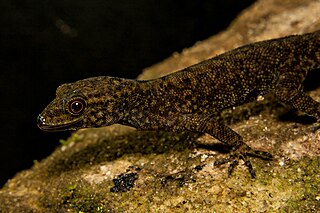
The yellow-browed bulbul, or golden-browed bulbul, is a species of songbird in the bulbul family, Pycnonotidae. It is found in the forests of southern India and Sri Lanka. The yellow-browed bulbul is mainly yellow on the underside and olive above with a distinct yellow brow. They are easily located by their loud calls but tend to skulk within foliage below the forest canopy. While its taxonomic classification has changed over time, it is currently the sole species within the monotypic genus Acritillas which is closely related to Hemixos.

Mudumalai National Park is a national park in the Nilgiri Mountains in Tamil Nadu, south India. It covers 321 km2 (124 sq mi) at an elevation range of 850–1,250 m (2,790–4,100 ft) in the Nilgiri District and shares boundaries with the states of Karnataka and Kerala. A part of this area has been protected since 1940. The national park has been part of Nilgiri Biosphere Reserve since 1986 and was declared a tiger reserve together with a buffer zone of 367.59 km2 (141.93 sq mi) in 2007. It receives an annual rainfall of about 1,420 mm (56 in) and harbours tropical and subtropical moist broadleaf forests with 498 plant species, at least 266 bird species, 18 carnivore and 10 herbivore species. It is drained by the Moyar River and several tributaries, which harbour 38 fish species.

Calotes grandisquamis, the large-scaled forest lizard, is an arboreal, diurnal, insectivorous agamid lizard found in the evergreen rainforests of the Western Ghats of India; distributed from Agumbe to Agasthyamalai Hills.
Beddome's day gecko is a species of lizard in the family Gekkonidae. The species is endemic to India.
Cnemaspis heteropholis, also known as the Gund day gecko or different-scaled day gecko, is a species of geckos found in India.

The coastal day gecko is a species of gecko found in the Western Ghats of India.
The Ponmudi day gecko is a species of lizard in the family Gekkonidae. The species is endemic to India.
The ornate day gecko is a species of gecko found in southern India.
Cnemaspis otai, also known commonly as Ota's day gecko or the Vellore day gecko, is a species of lizard in the family Gekkonidae. The species is endemic to southeastern India.
The Sispara day gecko is a species of gecko found in the Nilgiri Hills of India.

The rough-bellied day gecko is a species of day geckos found in the Western Ghats of India and Sri Lanka. Its distribution in the southern Western Ghats is patchy and relatively uncommon. It is active during the day. It has a distinct head, elongated snout, and keeled ventral scales; Its dark-brown dorsal side has transverse arrangement of light and dark variegations. It is pale brown/cream on its underside with spiny tubercles on its sides. Males have two to four preanal and three to six femoral pores.

The Wynad day gecko is a species of gecko. It is endemic to the Western Ghats in Kerala, India, and only known from two locations, Wayanad and Silent Valley National Park.

Cyrtodactylus deccanensis, also commonly known as Deccan ground gecko, Günther's Indian gecko, or the banded ground gecko, is a species of gecko found in the northern Western Ghats of India. It has been found from northern Maharashtra, with a habitat range possibly extending to southern Gujarat. Cyrtodactylus albofasciatus was previously considered conspefic with Cyrtodactylus deccanensis but is now accepted as a valid species.

The Southern Ghats slender gecko is a species of gecko with a restricted distribution in the hills of southern India.

The two-lined ground skink is a species of skink. It is found in the Nilgiri Hills and Travancore Hills of India.
Microauris is a monotypic genus of agamid lizard. Its only species is Microauris aurantolabium, also known as the small-eared dragon or orange-lipped forest lizard, found in the forests of the southern Western Ghats and is currently known from the Kalakkad Mundanthurai Tiger Reserve. The species was formerly included in Pseudocalotes andamanensis of the Andaman Islands, but recognized as distinct in 2008. It was also classified under Calotes until 2018, where it was transferred to its own genus, Microauris, on the basis of its divergence from Calotes.
The Kolhapur day gecko is a species of gecko described from the hills in Kolhapur in Maharashtra, India.
Cnemaspis adii, also known as Adi's day gecko, is a species of day gecko endemic to Hampi, India. The species was discovered in 2015 by Aditya Srinivasulu and his colleagues in the temple complex.
Cnemaspis australis, also known as the Southern Travancore day gecko, is a species of gecko endemic to Agasthyamalai Hills of the Southern Western Ghats, in the states of Tamil Nadu and Kerala in South India. It lives in rock boulders and is a evergreen forest dwelling diurnal, insectivorous and oviparous species. This species was previously confused with another gecko Mysore day gecko till a study in 2007 proved it to be a new species.










